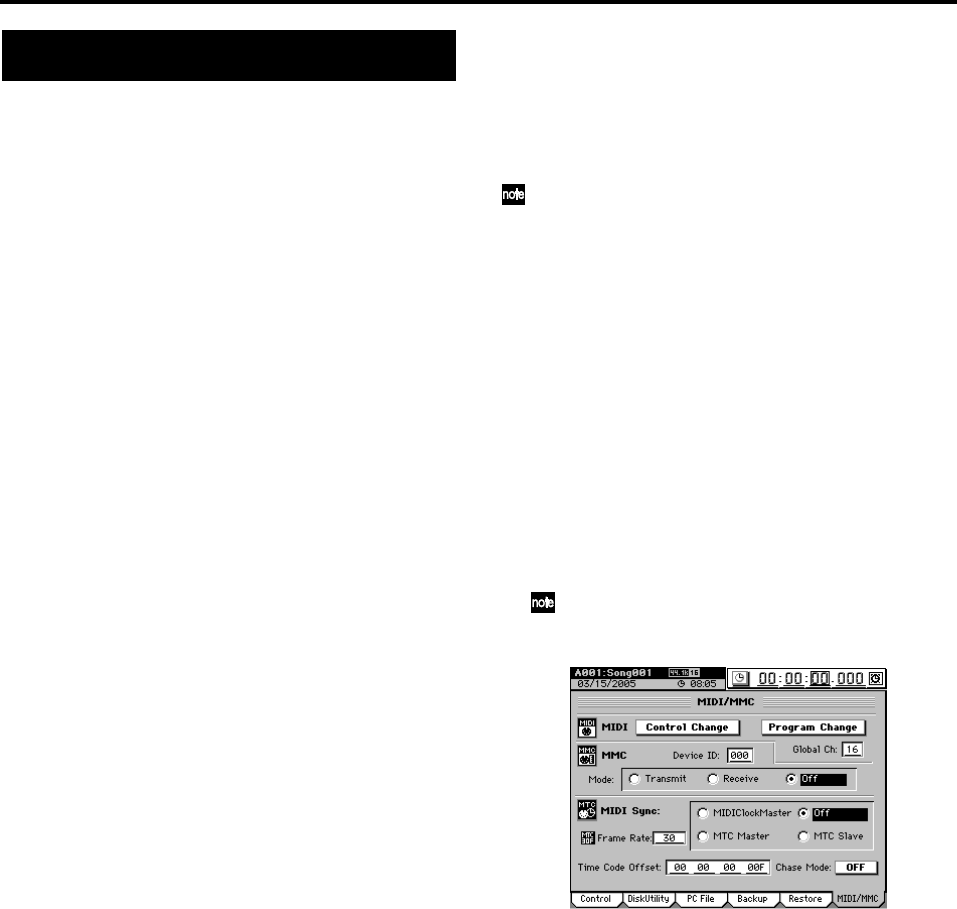
94
MIDI stands for Musical Instrument Digital Interface, and is
a world-wide standard used to exchange performance data
between electronic musical instruments and computers.
1. MIDI connections
Use only MIDI cables to transfer MIDI data. Connect these
cables between the MIDI connectors of the D3200 and the
MIDI connectors of the external MIDI device with which you
want to transfer data.
MIDI IN connector
Receives MIDI messages from another MIDI device.
Connect this to the MIDI OUT connector of the external
device.
MIDI OUT connector
Transmits MIDI messages from the D3200. Connect this
to the MIDI IN connector of the external device.
MIDI channel settings
MIDI uses sixteen channels (1–16) to independently convey
data to multiple MIDI devices. If the transmitting device is
sending data on MIDI channel “1,” the receiving device must
also be set to MIDI channel “1” in order to receive this data.
(→p.125 “3. Global Ch”)
2. MIDI messages used by the
D3200
Note On (Note, velocity), aftertouch, pitch-bend:
The D3200 uses these messages to control effects.
Program change:
The D3200 uses these messages to switch scenes.
Control change:
The D3200 uses these messages to control mixer and
effect parameters.
MMC (MIDI Machine Control):
MMC messages can be transmitted from the D3200 to
control an external MMC-compatible sequencer or
recorder. MMC messages received from an external
sequencer or recorder can be used to control the D3200.
MTC (MIDI Time Code):
The D3200 can transmit or receive MTC messages to
synchronize with an external sequencer or recorder.
MIDI Clock:
The D3200 can transmit MIDI Clock. It can also receive
MIDI Clock if you have selected MIDI Clock for the
tempo track and are recording the tempo track.
About the MIDI implementation chart
The owner’s manual of each MIDI device includes a MIDI
implementation chart. This chart shows the types of MIDI
message that the device can transmit and receive. When us-
ing two MIDI devices together, compare their MIDI imple-
mentation charts to verify that the devices will be able to
communicate as you expect.
*A detailed explanation of the D3200’s MIDI functionality can be
found in the separate MIDI implementation. Consult your local
Korg distributor for more information on MIDI Implementation.
3. Using MIDI
Controlling the D3200 from a MIDI sequencer
You can use MMC messages transmitted and received from
a MIDI sequencer to control D3200 operations such as stop,
play, record, and locate.
You must use a sequencer that supports MMC. These operations
cannot be performed from a sequencer that does not support
MMC.
(1) Use a MIDI cable to connect the two devices.
Use MIDI cables to connect the MIDI IN connectors and
MIDI OUT connectors of the D3200 and your MIDI
sequencer to each other.
(2) Adjust the settings on your MIDI sequencer.
Set your sequencer to transmit MMC and to receive
MTC (MTC Slave). For details, refer to the owner’s man-
ual of your MIDI sequencer.
(3) Turn on MMC reception.
In the SYSTEM/MIDI, “MIDI/MMC” tab page, set
“MMC Mode” to “Receive,” and set “MIDI Sync” to
“MTC Master.”
(4) Set the device ID to match.
Set the “Device ID” to match the MMC device ID of
your MIDI sequencer.
If you leave the “Device ID” set to 127, MMC commands
can be exchanged with any device.
(5) Operate your external MIDI sequencer.
When you perform stop, play, record, and locate opera-
tions on your MIDI sequencer, the D3200 will be control-
led. (For details, refer to the manual of your MIDI
sequencer.)
MIDI


















